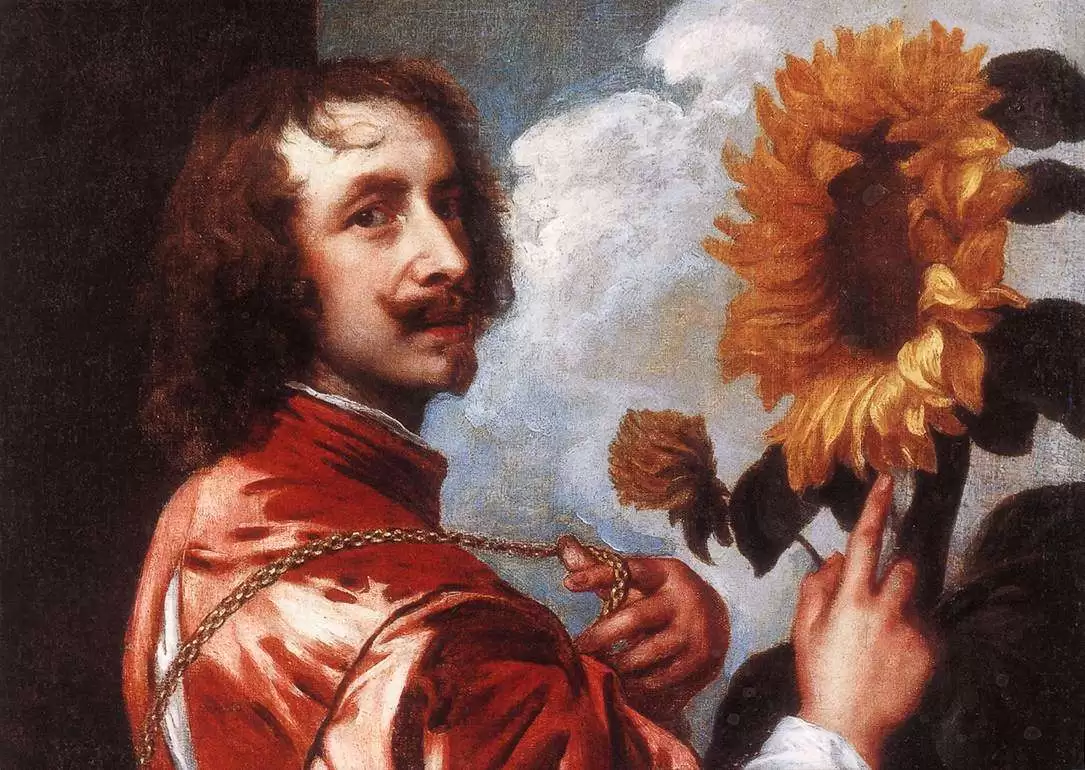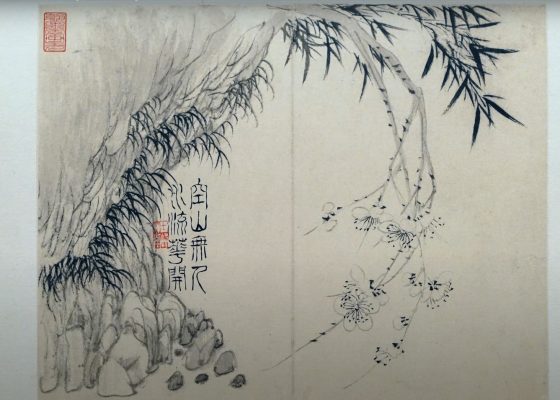
By Bethany Shepard
Sir Anthony van Dyck (alternately spelled Vandyke) was an influential Brabantian Flemish painter and Baroque artist of the 17th century. He was born in Belgium in 1599. After a prosperous career in the southern Netherlands and Italy, van Dyck became England’s preeminent court painter.
Sir Anthony van Dyck was the seventh child of Frans van Dyck, a wealthy Antwerp silk dealer. He was a precocious painter who began his career at a young age. His earliest works of independence date back to 1615-16, when he was only 17 years old. He achieved recognition as an independent artist in his late teens. By February 1618, van Dyck was welcomed to the Guild of Saint Luke of Antwerp painters as a free master.
One of Anthony van Dyck’s early influences was Sir Peter Paul Rubens, who is still regarded as the most prominent Flemish Baroque artist. Rubens described van Dyck as “the most talented of my students.”

Additionally, van Dyck studied and was greatly influenced by the works of Italian artists such as Titian.
Van Dyck was known for an eclectic variety of subjects and mediums. In Italy and Antwerp, Anthony van Dyck was a highly successful portraitist and painter of mythological and religious subjects. Van Dyck was also an accomplished engraver and draftsman. His depictions of Charles I and his court are highly renowned for their elegance.
Van Dyck travelled extensively as well. He was first employed by King James I of England, a position he resigned to travel to Italy. He spent the next six years there. He spent his second period in the Netherlands, where he was well-received and achieved considerable success. Despite earning a lucrative salary at the court of King James I, van Dyck returned to Antwerp. In October of 1621, he then departed for Italy. His first stop was in Genoa. Rubens assisted him in obtaining employment in Italy for the aristocratic family groups for whom he worked 14 years ago.
After spending time in Italy and the Netherlands, Van Dyck settled in 1632 at the English court.
The appealing and authoritative depiction of Charles I and his family established new standards for English portraiture. Court members were eager to procure commissioned portraiture with the same effect. In the seventeenth century, portraiture was the most in-demand kind of art. To take advantage of the opportunity, van Dyck persuaded King Charles I to launch a large-scale series on the history of the Order of the Garter, an English order of knighthood.

After returning to Antwerp from Italy, he focused on iconography for an extended period. He created a great number of paintings in the region. Among van Dyck’s most notable works are the following: Portrait of Cornelis van der Geest, Portrait of Giovanni Battista Cattaneo, and Portrait of a Woman and Child.


After achieving popularity, van Dyck established a large studio in England that included a number of his noteworthy paintings. This studio has become a portrait assembly line.
Van Dyck had a significant impact on English art, which generated many great artists throughout the years. In 1632, van Dyck was knighted in honor of the significant contribution of his works.

The styles depicted in his paintings became a widespread fad among the people of his time. For example, the Vandyke beard and collar were popular among the men of his time who served as his models. During the time of King George III, the Vandyke costume was extremely fashionable. One of his most often used colors, brown, was memorialized with the name “Vandyke brown.”
In conclusion, Anthony van Dyck was a wonderful artist that impacted countless people throughout the world for centuries. His legacy endures as his works are still greatly admired today.












Cancel anytime


Using our website
You may use the The Middle Land website subject to the Terms and Conditions set out on this page. Visit this page regularly to check the latest Terms and Conditions. Access and use of this site constitutes your acceptance of the Terms and Conditions in-force at the time of use.
Intellectual property
Names, images and logos displayed on this site that identify The Middle Land are the intellectual property of New San Cai Inc. Copying any of this material is not permitted without prior written approval from the owner of the relevant intellectual property rights.
Requests for such approval should be directed to the competition committee.
Please provide details of your intended use of the relevant material and include your contact details including name, address, telephone number, fax number and email.
Linking policy
You do not have to ask permission to link directly to pages hosted on this website. However, we do not permit our pages to be loaded directly into frames on your website. Our pages must load into the user’s entire window.
The Middle Land is not responsible for the contents or reliability of any site to which it is hyperlinked and does not necessarily endorse the views expressed within them. Linking to or from this site should not be taken as endorsement of any kind. We cannot guarantee that these links will work all the time and have no control over the availability of the linked pages.
Submissions
All information, data, text, graphics or any other materials whatsoever uploaded or transmitted by you is your sole responsibility. This means that you are entirely responsible for all content you upload, post, email or otherwise transmit to the The Middle Land website.
Virus protection
We make every effort to check and test material at all stages of production. It is always recommended to run an anti-virus program on all material downloaded from the Internet. We cannot accept any responsibility for any loss, disruption or damage to your data or computer system, which may occur while using material derived from this website.
Disclaimer
The website is provided ‘as is’, without any representation or endorsement made, and without warranty of any kind whether express or implied.
Your use of any information or materials on this website is entirely at your own risk, for which we shall not be liable. It is your responsibility to ensure any products, services or information available through this website meet your specific requirements.
We do not warrant the operation of this site will be uninterrupted or error free, that defects will be corrected, or that this site or the server that makes it available are free of viruses or represent the full functionality, accuracy and reliability of the materials. In no event will we be liable for any loss or damage including, without limitation, loss of profits, indirect or consequential loss or damage, or any loss or damages whatsoever arising from the use, or loss of data, arising out of – or in connection with – the use of this website.
Last Updated: September 11, 2024
New San Cai Inc. (hereinafter “The Middle Land,” “we,” “us,” or “our”) owns and operates www.themiddleland.com, its affiliated websites and applications (our “Sites”), and provides related products, services, newsletters, and other offerings (together with the Sites, our “Services”) to art lovers and visitors around the world.
This Privacy Policy (the “Policy”) is intended to provide you with information on how we collect, use, and share your personal data. We process personal data from visitors of our Sites, users of our Services, readers or bloggers (collectively, “you” or “your”). Personal data is any information about you. This Policy also describes your choices regarding use, access, and correction of your personal information.
If after reading this Policy you have additional questions or would like further information, please email at middleland@protonmail.com.
PERSONAL DATA WE COLLECT AND HOW WE USE IT
We collect and process personal data only for lawful reasons, such as our legitimate business interests, your consent, or to fulfill our legal or contractual obligations.
Information You Provide to Us
Most of the information Join Talents collects is provided by you voluntarily while using our Services. We do not request highly sensitive data, such as health or medical information, racial or ethnic origin, political opinions, religious or philosophical beliefs, trade union membership, etc. and we ask that you refrain from sending us any such information.
Here are the types of personal data that you voluntarily provide to us:
As a registered users or customers, you may ask us to review or retrieve emails sent to your business. We will access these emails to provide these services for you.
We use the personal data you provide to us for the following business purposes:
Information Obtained from Third-Party Sources
We collect and publish biographical and other information about users, which we use to promote the articles and our bloggers who use our sites. If you provide personal information about others, or if others give us your information, we will only use that information for the specific reason for which it was provided.
Information We Collect by Automated Means
Log Files
The site uses your IP address to help diagnose server problems, and to administer our website. We use your IP addresses to analyze trends and gather broad demographic information for aggregate use.
Every time you access our Site, some data is temporarily stored and processed in a log file, such as your IP addresses, the browser types, the operating systems, the recalled page, or the date and time of the recall. This data is only evaluated for statistical purposes, such as to help us diagnose problems with our servers, to administer our sites, or to improve our Services.
Do Not Track
Your browser or device may include “Do Not Track” functionality. Our information collection and disclosure practices, and the choices that we provide to customers, will continue to operate as described in this Privacy Policy, whether or not a “Do Not Track” signal is received.
HOW WE SHARE YOUR INFORMATION
We may share your personal data with third parties only in the ways that are described in this Privacy Policy. We do not sell, rent, or lease your personal data to third parties, and We does not transfer your personal data to third parties for their direct marketing purposes.
We may share your personal data with third parties as follows:
There may be other instances where we share your personal data with third parties based on your consent.
HOW WE STORE AND SECURE YOUR INFORMATION
We retain your information for as long as your account is active or as needed to provide you Services. If you wish to cancel your account, please contact us middleland@protonmail.com. We will retain and use your personal data as necessary to comply with legal obligations, resolve disputes, and enforce our agreements.
All you and our data are stored in the server in the United States, we do not sales or transfer your personal data to the third party. All information you provide is stored on a secure server, and we generally accepted industry standards to protect the personal data we process both during transmission and once received.
YOUR RIGHTS/OPT OUT
You may correct, update, amend, delete/remove, or deactivate your account and personal data by making the change on your Blog on www.themiddleland.com or by emailing middleland@protonmail.com. We will respond to your request within a reasonable timeframe.
You may choose to stop receiving Join Talents newsletters or marketing emails at any time by following the unsubscribe instructions included in those communications, or you can email us at middleland@protonmail.com
LINKS TO OTHER WEBSITES
The Middle Land include links to other websites whose privacy practices may differ from that of ours. If you submit personal data to any of those sites, your information is governed by their privacy statements. We encourage you to carefully read the Privacy Policy of any website you visit.
NOTE TO PARENTS OR GUARDIANS
Our Services are not intended for use by children, and we do not knowingly or intentionally solicit data from or market to children under the age of 18. We reserve the right to delete the child’s information and the child’s registration on the Sites.
PRIVACY POLICY CHANGES
We may update this Privacy Policy to reflect changes to our personal data processing practices. If any material changes are made, we will notify you on the Sites prior to the change becoming effective. You are encouraged to periodically review this Policy.
HOW TO CONTACT US
If you have any questions about our Privacy Policy, please email middleland@protonmail.com
The Michelin brothers created the guide, which included information like maps, car mechanics listings, hotels and petrol stations across France to spur demand.
The guide began to award stars to fine dining restaurants in 1926.
At first, they offered just one star, the concept was expanded in 1931 to include one, two and three stars. One star establishments represent a “very good restaurant in its category”. Two honour “excellent cooking, worth a detour” and three reward “exceptional cuisine, worth a
Thank you for your participation,
please Log in or Sign up to Vote

123Sign in to your account